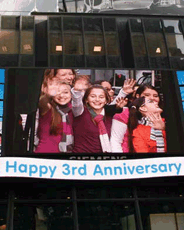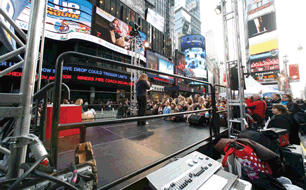Penguins in the Big City

Disney’s Club Penguin has become an internet sensation for kids across the globe, so it seemed
A live video feed was run to ABC’s LED screens on the side of its building. appropriate when the show took over part of Times Square in New York City for Club Penguin’s Third Anniversary event, which was also webcasted to the world. Blu Laser Digital stepped in to assist Disney in making the event something special for attendees, even if they were remote.
Robert Sullivan, general manager for Blu Laser Digital, explained the client’s technical goals for the event: “The plan started with wireless HD Cano-Beam signal from the stage show taking place on Military Island in Times Square to go to the LED marquee on the adjacent 44th Street and Broadway Toys ‘R’ Us, called the ‘Geoffery-tron,’ and they wanted another feed to go to screens inside of the store. The final signal path included the feed going to the ‘wraparound’ LED screens on the ABC Broadcast building with a live uplink of the event on the website ClubPenguin.com.”

Blu Laser Digital provided support for Club Penguin’s Times Square event. distribution of all graphics and video from the multiple cameras at the event. “We were basically switching two separate shows, one for the screens and one for the web,” says Sullivan. “Additionally delaying the web feed, in case of a mishap with live attendees in NYC at the event, since it was for a children’s website. Luckily we had no incidents whatsoever.”
Sullivan continues, “There was a full audio and lighting rig supporting a stage show on Military Island with Disney Channel and Radio Disney emcees and a dance troop performing. There were plasma screens with wired and wireless feeds going to the screens. Inside Toys ‘R’ Us, there was an area dedicated to Club Penguin. Included in the setup were five internet kiosks with a software security lock so kids could browse the Club Penguin website exclusively. There was a face painting area, a storyteller, a crayon coloring station, a couple of photo ops, banners, and a step-and-repeat. It was very exciting for the kids, and was really well put together by the producers at Disney.”

Five internet kiosks were set up in Toys’R’Us to allow children to access the Club Penguin website, which was webcasting the event live. We brought in a switch package that utilized the NewTek webcasting device called a Tricaster. We had three of those on site: a prime, a backup, and a redundant backup. We were able to get a static IP address up to the main servers where we connected with Limelight Networks, which provided the uplink to Disney and the Club Penguin website. They had capacity for between 100,000 and 500,000 online viewers for this feed.”
Blu Laser Digital also collaborated with a couple other vendors. “Disney contracted everything through us, and we utilized our collaborative partner in NYC for the use of the Tricaster, Varto Technologies,” states Sullivan. “We also worked with Lonnie Hamilton from Red Hawk Productions, who project managed the show for us. Equipment-wise, we also got some gear from VER.”
A daily selection of the top stories for AV integrators, resellers and consultants. Sign up below.
Working in a venue like Times Square offered several challenges for Blu Laser Digital. “Through several preproduction surveys and meetings, there were several political elements that were involved with maintaining the use of Military Island,” says Sullivan. “It does take some footwork to be able to set up meetings with traffic buzzing all around and go through all the technical aspects on the property, with the staff of local government and police officials to support the event.
“Being given the opportunity to put on an event in Times Square was exciting for us. This was our first experience doing such an event. For the local officials, however, it was just another day. When we arrived at show site, the bicycle barricades were already in place to provide a perimeter for the safety and security of our staff and gear, as well as the public. Everyone was very accommodating in NYC for our needs.”
One small incident almost prevented the show from running so smoothly. “The logistics of being in Times Square and getting equipment in and out was a challenge,” Sullivan notes. “We had generators powering everything there. We had one generator go down the morning of and we had to switch it out during rush hour traffic. We had to shut down two lanes to bring the generator in at 7:45 AM the morning of the show. The timeline was rough, giving us less than 24 hours for setup and rehearsal, show time, and strike. We were given the space at midnight and had to clear out by midnight. But we felt like it was a big success and so did the client.”
